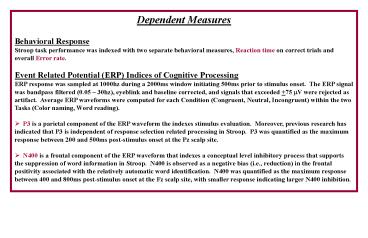Dependent Measures PowerPoint PPT Presentation
1 / 8
Title: Dependent Measures
1
- Dependent Measures
- Behavioral Response
- Stroop task performance was indexed with two
separate behavioral measures, Reaction time on
correct trials and overall Error rate. - Event Related Potential (ERP) Indices of
Cognitive Processing - ERP response was sampled at 1000hz during a
2000ms window initiating 500ms prior to stimulus
onset. The ERP signal was bandpass filtered
(0.05 30hz), eyeblink and baseline corrected,
and signals that exceeded 75 ?V were rejected as
artifact. Average ERP waveforms were computed
for each Condition (Congruent, Neutral,
Incongruent) within the two Tasks (Color naming,
Word reading). - P3 is a parietal component of the ERP waveform
the indexes stimulus evaluation. Moreover,
previous research has indicated that P3 is
independent of response selection related
processing in Stroop. P3 was quantified as the
maximum response between 200 and 500ms
post-stimulus onset at the Pz scalp site. - N400 is a frontal component of the ERP waveform
that indexes a conceptual level inhibitory
process that supports the suppression of word
information in Stroop. N400 is observed as a
negative bias (i.e., reduction) in the frontal
positivity associated with the relatively
automatic word identification. N400 was
quantified as the maximum response between 400
and 800ms post-stimulus onset at the Fz scalp
site, with smaller response indicating larger
N400 inhibition.
2
- Behavioral Effects
3
- Behavioral Effects
Error rate As expected, similar significant
Task, Condition, and Task X Condition effects
were observed for error rates. A significant
Beverage X Task X Condition effect, F(1,46)
3.40, p .042, was also observed. Follow-up
Boneferroni-corrected simple effect tests
revealed a significant increase in error rate
among intoxicated participants in the color
naming interference condition, t(46) 2.66, p
.011.
Reaction time Consistent with the overall Stroop
literature, significant Task, Condition, and Task
X Condition effects were observed for reaction
time. A significant Beverage X Task effect,
F(1,46) 4.51, p .039, was also observed.
Specifically, a larger Task effect was observed
among intoxicated participants with these
individuals exhibiting generally slower color
naming and faster word reading than sober
participants.
4
P3 Index of Stimulus Evaluation
5
- P3 Index of Stimulus Evaluation
- A significant main effect of Task, F(1,46)
35.28, p lt .001, was observed for P3 magnitude
with greater P3 displayed during word reading
than color naming, indicating superior
attentional processing of word relative to color
information. A significant effect of condition,
F(2, 45) 4.94, p .012, was also observed,
with increased P3 during congruent and
incongruent conditions relative to the neutral
condition. - No main effect or interactions involving Beverage
were observed for P3 magnitude, indicating that
alcohol did not affect stimulus evaluation of
either word or color information. Moreover,
alcohol did not affect the latency of the P3
response, indicating that the locus of the
alcohols effect on reaction time occurred at a
stage of processing after stimulus evaluation.
6
N400 index of Inhibitory Processing
7
- N400 index of Inhibitory Processing
No-alcohol Among non-intoxicated participants,
significant effects of Task, F(1,23) 7.98, p
.010, and Task X Condition, F(2,22) 4.53, p
.024, were observed. Specifically, sober
individuals displayed greater N400 inhibition of
frontal positivity during color naming than word
reading. Moreover, significant linear increase
in N400 inhibition across congruent to neutral
to incongruent conditions was limited to the
color naming task, F(2,22) 6.33, p .007. No
condition effect on N400 was observed during word
reading.
Alcohol Intoxicated participants did not exhibit
the main effect of Task on N400 observed among
sober participants. Moreover, intoxication
participants displayed significantly less N400
inhibition during color naming than did their
non-intoxicated counterparts, F(1,46) 4.91, p
.032. Intoxicated participants did display a
trend toward a Task X Condition effect (p .067)
with significant linear increase in N400
inhibition during color naming (p .002) but not
word reading.
8
- Conclusions
- Alcohol significantly impaired context
appropriate adaptive behavioral response when
that response had to compete with an
incompatible, relatively automatic, pre-potent
response. Specifically, intoxicated behavioral
impairment was evidenced as increased error rates
when automatic, pre-potent response was incorrect
(i.e., incongruent color naming) and as an
overall relative slowing of response time when
more controlled-processing was required (i.e.,
all color naming conditions). - These behavioral deficits associated with
intoxication did not appear to result from
deficits in attentional allocation to initial
stimulus evaluation. Specifically, alcohol did
not reduce the magnitude or delay the latency of
the P3 component of the ERP, an
electrophysiological index of stimulus
evaluation, regardless of task or condition. - Alcohol intoxication produced impairment in a
frontal inhibitory process required to suppress
or attenuate the influence of contextually
inappropriate but pre-potent word information on
response selection processes during color naming.
Specifically, intoxicated participants exhibited
significantly less N400 inhibition of frontal
positivity during color naming.

